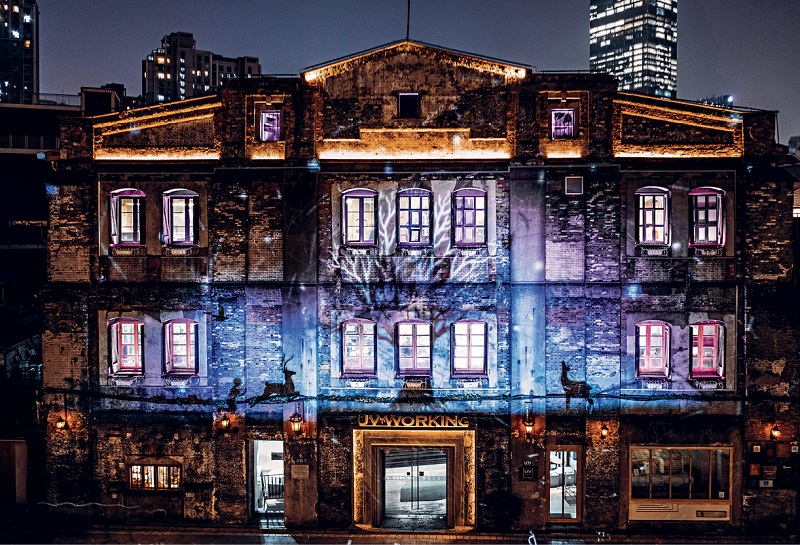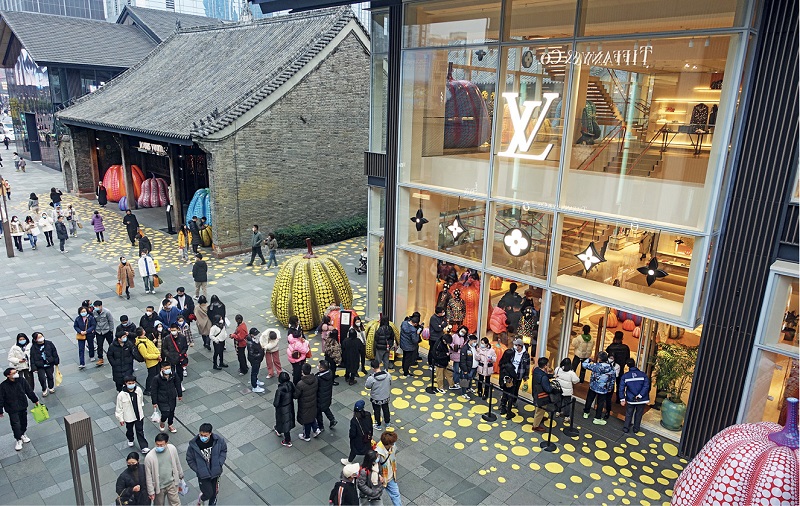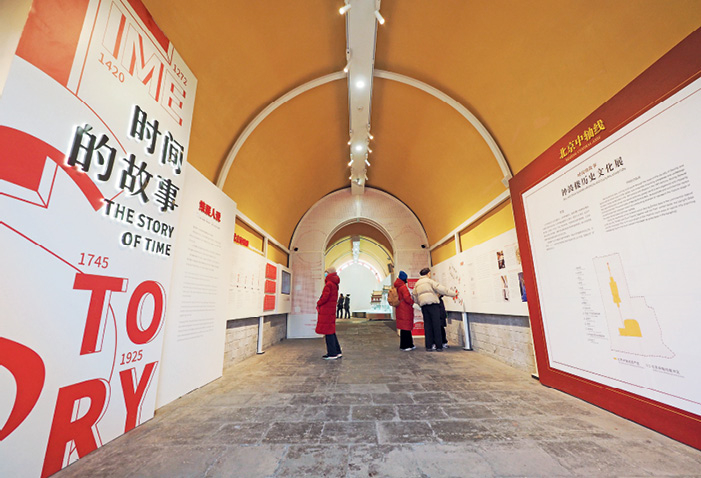– Dialogue with the Deans of Architecture Schools in China and Spain

A light and shadow show is put on along the Suzhou River in Shanghai on January 18, 2022.
Political and economic volatility and the daunting challenge of global economic recovery notwithstanding, countries are seeking ways to improve people’s living environments through more scientific and people-oriented urban planning. Chinese President Xi Jinping set great store, during his recent inspection tours of Shandong, Shanghai, and Chongqing, on ecological protection and the people-oriented development principles of urban planning.
In a recently published report projecting a global urban development trend in 2030, Deloitte indicated the widespread application of smart transportation and urban management, green and people-friendly public spaces, and more accessible public facilities, among others.
China – a rising pace-setter in green development, and Spain – a bellwether of the preservation of ancient buildings and the construction of superblocks – have had frequent exchanges in the urban planning and construction sector. China Today sat down with Li Xiangning, former dean of the College of Architecture and Urban Planning, Tongji University, and currently director of the university’s Academic Affairs Department; and Felix Solaguren-Beascoa De Corral, director of the Barcelona School of Architecture, to gain greater insight into how the two countries respectively make their urban blocks greener and more livable and renew ancient buildings in the contemporary era.
China Today: Over the past decade, what new changes and characteristics have emerged in urban planning in China and Spain? And what is your opinion of the new characteristics that define urban development today?
Li Xiangning: At the initial stage of China’s reform and opening-up in the 1980s and 90s, when new communities and buildings mushroomed to meet the needs of development, our focus was on technical factors, such as the density of buildings and transportation accessibility. Cities hence developed in an extensive way. However, the past decade has seen a more people-oriented trend in China’s urban development, evident in the priority accorded to living convenience and convivial communities. That energy-saving and carbon-reduction have become key concerns in urban planning is another striking feature. Shanghai, for example, is building 15-minute community life circles for its citizens that make communities “suitable for living, working, relaxing, learning, and wellbeing.” With markets, shops, parks, and other public facilities within easy reach, citizens may enjoy more convenient living within the 15-minute walk radius, which greatly reduces transportation needs and diminishes the carbon footprint.
Felix Solaguren-Beascoa De Corral: Climate change has become a major challenge for the world as a whole. Catalonia, for example, experiences no rain for months at a time. This causes heatwaves, severe droughts, and consequently brutal problems in the agricultural sector. As regards housing, escalating property prices in some parts of Spain have forced people to move out of cities to more remote areas. This entails lengthy commutes to work by car and other means of transportation, all of which exacerbate air pollution.
Wood is the ideal material for green buildings. But as certain countries, including Spain, have insufficient resources in this regard, they need to import wood. This, again, necessitates carbon emission-generating transportation. It is therefore imperative to take full advantage of local materials.

At a shopping center in Chengdu, an LV store is putting on a promotion activity on January 31, 2023.
China Today: As climate change has become the global common challenge, green and low-carbon urban design is in vogue. Could you please elaborate on such practices in China and Spain?
Li Xiangning: As regards the standard for green buildings, China is the undisputed world frontrunner. Nowadays, all government-financed public buildings in our country have to pass environmental impact and sustainability assessments, by virtue of such energy-saving applications as specifically designed heating and cooling systems, and ground-source heat pumps. China has thus exercised effective carbon emission and energy consumption control in the construction field. Obtaining government approval for a building means fulfilling the relevant energy saving requirement from the planning stage through to construction. Governmental compulsory requirements hence play a constructive role in the growing green trend. In fact, our urban planning also emphasizes the concept of harmonious coexistence between human beings and nature. Last year, I curated Shanghai’s urban art season, themed “symbiosis.” It accentuated just how crucial it is to achieve balanced and harmonious development of humankind and nature in the urban sphere.
Felix Solaguren-Beascoa De Corral: Using local materials to promote green coverage is, of course, beneficial. However, there are much deeper problems to resolve beyond creating green building façades, which only mask them. Rooting out pollution calls for global cooperation, political consensus, and sensible decisions – all of which demand much more effort. Tackling pollution and garbage needs systematic solutions.
China Today: Many cities in China and Spain have a history of hundreds or even thousands of years. Protection of ancient buildings and historical landscapes has hence become a vital task for cities in both countries. Meanwhile, how to renew or revitalize ancient buildings has topped the agenda of certain urban planners. Could you please elaborate on some practices in this regard in China and Spain?
Li Xiangning: Over the past four decades, awareness of the need to protect and preserve ancient buildings has become greatly reinforced among Chinese people. It’s not just ancient buildings but certain old houses, even those built a few decades ago retaining striking features of that specific era, that we want to preserve. For citizens, such old houses carry memories of that era which they want to keep alive. However, preserving old architecture doesn’t preclude the possibility of renewing and reusing it in the new era. Renovation can give an old house a new look, by incorporating the styles of different eras into one building. Both China and Spain have a wealth of world heritage sites that enable us to learn from each other the art of world heritage protection. There are various ways of revitalizing ancient heritage. For example, the Forbidden City in Beijing is well protected and may not be modified in any way. A range of cultural and creative products based on the Forbidden City that are very popular among people have hence been created, which renew its culture and spirit.
Felix Solaguren-Beascoa De Corral: I think it’s important for some old buildings to be reused and renewed in the contemporary era. For example, we’ve been working with textile factories along the Llobregat River, built in the late 19th century, which were very prosperous during World War I. They supplied textiles for the uniforms worn by soldiers battling in Europe at that time. At the end of the war, how to reuse these buildings became an issue. I think that all you can do is to remold, reshape, and modify. For example, after bullfighting was banned in the Spanish Autonomous Community of Catalonia in 2010, a renowned bull ring in Barcelona, built in 1900, was remodeled as a commercial complex and opened to the public in 2011. Letting it stand derelict was just not logical.
We must take the initiative to adapt old buildings to the new needs of urban residents. Retaining their spirit seems like a good idea to me.

Visitors walking around the historical and cultural exhibition about the Drum Tower inside the ancient building in Beijing on December 30, 2023.
China Today: While protecting and renewing old buildings, a city also needs to construct new ones that reflect local characteristics and the cultural traditions of a country and adapt to local special needs. Can you talk about China and Spain’s practices in this regard?
Li Xiangning: While learning from other countries, it’s also important to preserve and shape our unique style of urban planning. China is a big country with cities that have different development histories and styles. For Beijing, an ancient capital city with many ancient buildings, it’s important to preserve the ancient capital layout, including hutongs, because they act as records of people’s lives over different historical periods. However, the modern metropolis Shanghai has different features, being a product of Chinese and Western cultural fusion. We must hence take different approaches to preserving and shaping the styles of different cities.
Felix Solaguren-Beascoa De Corral: It’s important to retain a city’s characteristics, but every city wants an iconically new building. However, this generally only stays in vogue for around 10 years and then fades from favor. That’s why it’s necessary to maintain certain local architectural monuments. A building can be renovated to adapt to new times, even after a relatively long period. The Guggenheim Museum, a magnificent example of the most groundbreaking 20th-century architecture in Bilbao, northern Spain, was a catalyst for the city's renewal. Many cities tried to replicate this model, but it did not work as well as in Bilbao.
China Today: In the field of urban planning, China and Spain have had a lot of exchanges as both of them have some excellent practices worth promotion. Would each of you like to share your views about this?
Li Xiangning: I think China's entire urban model, especially the concept of modern cities, has been greatly influenced by the West. For example, Tongji University, under the influence of German urban planning, was the first university in the country to offer courses in urban planning. But it was, of course, also influenced by Spain. For example, Barcelona's neighborhood system and its corner-cut urban model are reflected in the planning of many of our new communities. There have been many exchanges in urban planning between China and Spain. For example, the so-called superblock is a famous project in Barcelona. In reducing the number of lanes to make room for public spaces, the superblock improves community service, which is recommendable.
Meanwhile, China’s highly efficient urban management has greatly impressed our Spanish colleagues. They are particularly impressed by our urban governance technology, for example, that of emergency response. They regard it as valuable and commend its enabling of the rapid transmission of information and evacuation of people.
Felix Solaguren-Beascoa De Corral: I think the urban layout of Barcelona is commendable. With a hybrid program model, the city has housing, shops, offices, facilities, and green spaces all within citizens’ 15-minute radius. It has an urban net that is equal in all directions, that is to say, equal among the entire society, and equi-distant to the school, as the school is almost the same distance from any house. I think an urban net that’s equal for everybody, and hence denotes an equal society, is ideal. Everyone derives the same possibilities, as people have the same facilities and equal access to them. So it’s perfect.